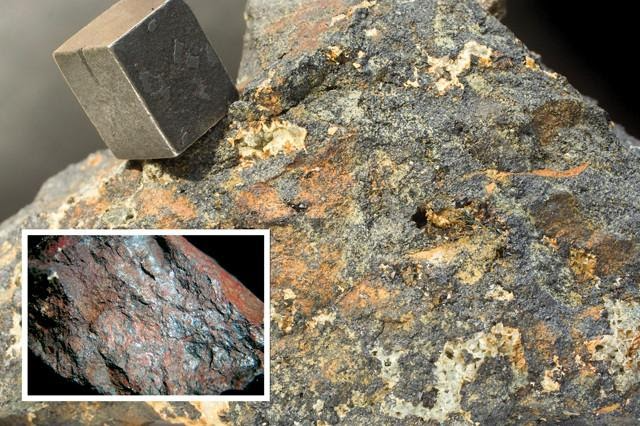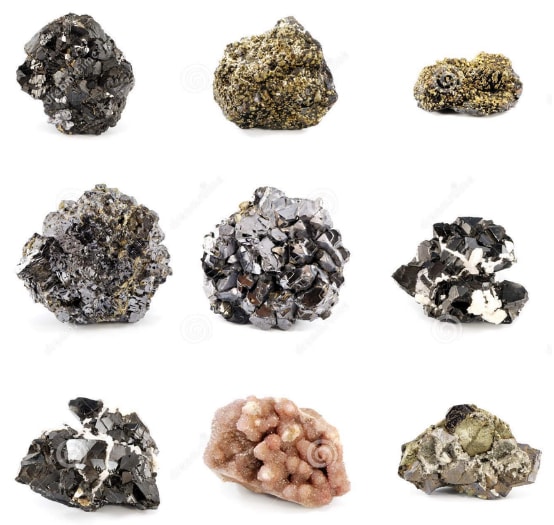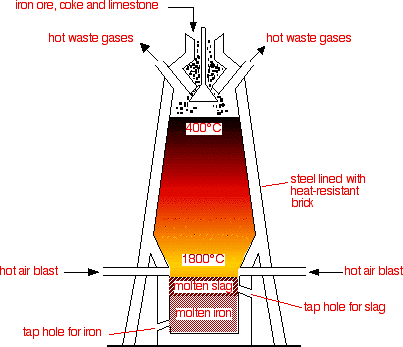Ores and Minerals - Difference, Definition, Examples with FAQs
What is the meaning of ore?
We all are very familiar with the fact that the earth’s crust is made of rocks. On closely observing the rocks, many different bits are noticed; some being dull while others, shiny. Minerals obtained are impure. Hence, they are processed, treated and then sold in the market. The main idea behind this is that all these components occur naturally and are not the products of human activity (mam-made) or are manufactured in a factory. A naturally occurring compound or an element is called Mineral. Ore is simply a rock containing a great percentage of a certain mineral.
Define ore:-
Natural rock or sediment containing one or more priceless and valuable minerals is defined as ore.
Ore meaning:-
The meaning of ore can be understood by the following statement-
An origin or a source used to extract minerals (especially metals) is called an ore.

Ore extraction from the earth is executed by mining and further refining them by a certain directed process resulting in the extraction of required minerals or metals. The concentration of the desired material the ore comprises is referred to as the grade of ore. The value of the metals or minerals the sediment contains is weighed against the cost of extraction to determine whether it is of sufficiently high grade to be worth mining, and is therefore considered an ore.
Also read -
Examples of ores:-
Four kinds of ores exist as follows-
Oxides
Aluminium: Bauxite - Al2O3.2H2O
Copper: Cuprites - Cu2O
Iron: Hematite - Fe2O3
Tin: Cassiterite - SnO2
Carbonates
Calcium : Limestone - CaCO3
Zinc : Calamine - ZnCO3
Iron : Siderite - FeCO3
Sulphides
Zinc : Zinc Blend - ZnS
Copper : Copper glance - Cu2S
Lead : Galena - PbS
Mercury : Cinnabar - HgS
Halides
Sodium : Rock salt - NaCl
Flouride : Flourspar - CaF2
Silver : Horn silver - AgCl
Ore Minerals:-

We’ve come across the terms – ores and minerals previously. Now, what are ore minerals?
Metal ores are typically oxides, sulphides, silicates or native metals ( generally includes native copper metal) now no longer typically focused or concentrated within the crust of the earth, or noble metals ( no longer forming chemical compounds) such as gold. To remove the elements of concern from the waste and the ore crystals, the ores are ought to be extracted. A type of geological procedure shapes ore bodies.
The formation of the ore technique is referred to as the genesis of the ore. The ore quality and the density of the rock or steel ore, in addition to its prevalence type, can at once have an affect on the ore mining costs. It is consequently vital to weigh the extraction fee in opposition to the steel price contained withinside the rock to decide which ore may be processed and which ore is just too low a grade to be really well worth mining. A part of an ore that isn’t economically suited and that can’t be averted in mining is referred to as gangue.
The precious mineral ores are separated from the gangue minerals via way of means of froth floatation, gravity concentration, and different operations acknowledged together as mineral processing or ore dressing. Ore Mineral deposits are categorized in keeping with-one-of-a-kind standards which have been hooked up via the observe mineral genesis. The classification of ore minerals is as follows:-
Hydrothermal epigenetic Deposit.
Granite related hydrothermal
Magnatite deposits
Volcanic-related deposits
Metamorphically reworked deposits
Carbonatite-alkaline igneous related
Sedimentary deposits
Sedimentary hydrothermal deposits
Astrobleme related ores
Minerals and ores:
A mineral is a naturally occurring substance obtained by mining that contains the metal in a free state or combined state.
An ore is a mineral comprising a high percentage of required metal, from which the pure metal can be obtained is called an ore.
Some metals being highly reactive find it difficult to exist individually. They exist in a combined state with other elements in the form of oxides, sulphides, carbonates, etc. These elements existing in a combined state with other elements is called ore. Raw materials used for making metals are ores. Minerals are the ones wherein the crystals are composed of unit cells or simple unit layers of or one or more types.
Difference between mineral and ore:-
ORE | MINERAL |
Ore is minerals from where metals are extracted. | Naturally occurring inorganic chemical compounds existing in the earth’s crust. |
Absence of definite crystalline structure. | Presence of definite crystalline structure. |
All ores are minerals. | All minerals aren’t ores. |
Availability of an adequate percentage of metals. | It may or may not contain a sufficient quantity of metal. |
Eg- Bauxite, Cryolite | Eg- Clay |

Also, students can refer,
- NCERT Solutions for Class 12 Chemistry Chapter 6 General Principles and Processes of isolation of
elements - NCERT Exemplar Class 12 Chemistry solutions Chapter 6 General Principles and Processes of isolation of
elements - NCERT notes Class 12 Chemistry Chapter 6 General Principles and Processes of isolation of elements
Metallurgy:-
Metallurgy is a process put in practice for the extraction of metals in their natural form. The compounds of metals blended with soil, limestone, sand and rocks are referred to as minerals. Metals are commercially extracted from minerals at a low value and with minimal effort. These minerals are referred to as ores. A substance added to the charge of the furnace to remove the impurities present i.e. gangue is known as flux. Metallurgy offers the system of purification of metals and the formation of alloys.
Let us have a look at the most common ore minerals used in day to day life by people-
Some metals being reactive do not exist in a free state but in a combined form with elements like Sulphur, Oxygen, Carbon and Halogens in the form of sulphides, oxides, carbonates, and Halide form respectively.
Elements like potassium, zinc, iron, lead etc. are found blended with other elements.
Abundances of the metals in the earth’s crust-
Aluminium - 8.1
Iron - 5.0
Calcium - 3.6
Sodium - 2.8
Potassium - 2.6
Magnesium – 2.1
All others - 1.5
Aluminium is the element available in maximum quantity however, iron performed a far more important and functional role in human records and is a critical part of everything! Iron is one in every 94 naturally occurring elements. Its atomic number is 26 and is represented as Fe. It contains approximately 5% of the earth’s crust.
Also check-
- NCERT Exemplar Class 11th Chemistry Solutions
- NCERT Exemplar Class 12th Chemistry Solutions
- NCERT Exemplar Solutions for All Subjects
NCERT Chemistry Notes: